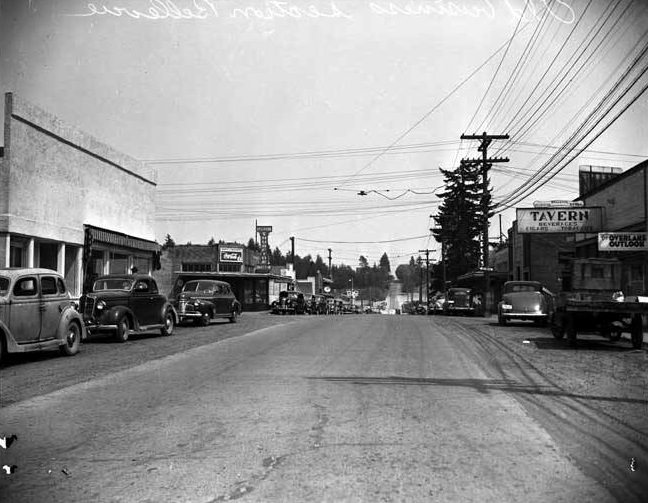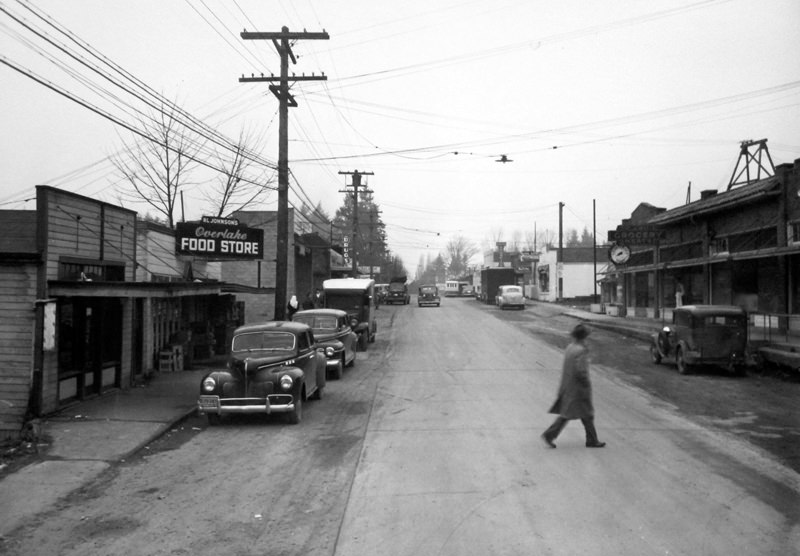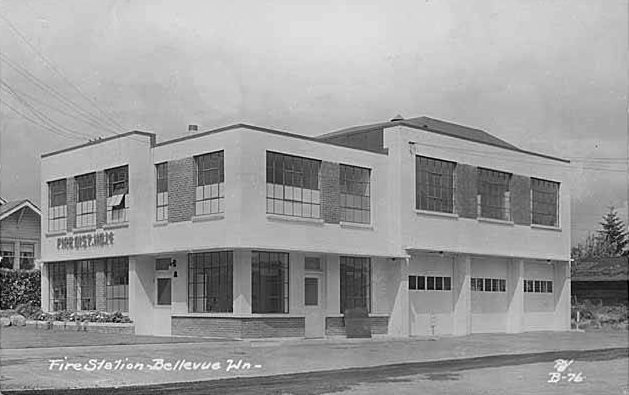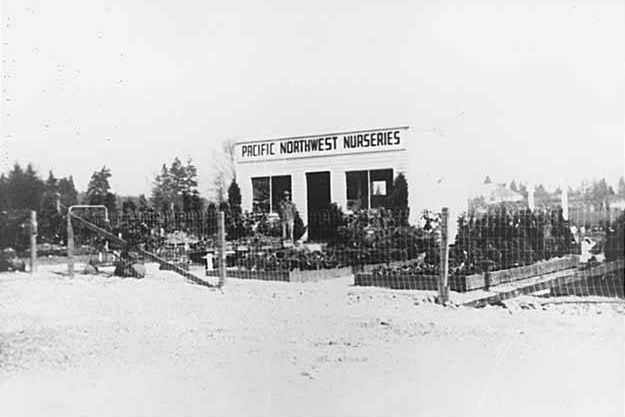The Lake Washington Floating Bridge opened in the 1940s when Bellevue mainly was farmland. A postwar housing boom spilled across the bridge and forever changed Bellevue after the Bellevue Chamber of Commerce began advertising and cheap land became available. New subdivisions sprang up along the new highway at Eastgate, Newport Hills, and Lake Hills, providing attractive, affordable housing to returning GIs and their families.
The Strawberry Festival in Bellevue was canceled in 1942. A large percentage of the agricultural workers in the area were of Japanese ancestry, and all of them had been forced into internment camps following the outbreak of World War II. The fair would not be revived for 45 years. A large amount of farmland became available for development following the expulsion of the ethnic Japanese farming community. A result of this was the development of the Bellevue downtown area.
New high schools and secondary and elementary schools were built along a hillcrest southeast of downtown in 1949, as were several dozen secondary and elementary schools and a community college. As the small-town atmosphere evaporated, suburban Bellevue took on a pleasant sophistication. In the 1930s, a golf course abandoned during the Great Depression was exhumed and resurrected, as was a second course east of town.
Bellevue looked different in the 1940s, and these historical photos will take you back to old Bellevue.
#1 Bellevue Square looked like a few days before Christmas, 1949.
#2 Another view of Main Street in Bellevue, May 1946.
#3 Bellevue, 1940s
#4 This picture from May 1946 shows the future home of Kaiser and Fraser Cars Rototillers and Farm Equipment.
#5 Main Street in Bellevue, May 1946.
#6 Excavation near the site that became home to Kaiser and Fraser Cars and Eckern’s Bellevue Automotive Company, 1946
#7 Homes under construction in what’s now downtown Bellevue, 1946
#8 Bel-Vue Theater and what was then called the Bellevue Shopping Center being built, 1946
#9 Bellevue Shopping Center, 1947
#10 Main Street in the original business district of Bellevue, 1949
#11 Aerial shot of Meydenbauer Bay,1948 southeast facing.
#12 Meydenbauer Bay, viewed to the east, 1944.
#13 Bellevue Square, 1948
#14 Cable laying operation during the laying of telephone cable across Lake Washington between Bellevue and Seattle using the barge TELEPHONE II, 1940s
#15 Bellevue High School, Bellevue, 1949
#16 Bellevue Public Library, Bellevue, 1944
#17 Bellevue Shopping Square and parking lot showing Kandy Kane Restaurant and Bell-Vue Theatre, Bellevue, 1947
#18 Boat on shore in Bellevue, Washington, 1940
#19 Burrows family log cabin, Killarney (now Bellevue), Washington, 1940

In 1882, Albert Burrows (1837-1896) moved his family from Des Moines, Iowa, to Seattle, Washington, where he got a job in a sawmill. He met George Miller, who had homesteaded with his family at Beaux Arts (area of present-day Bellevue) in 1883 and was looking for other families to settle nearby in order to organize a school. As a Civil War veteran, Burrows was entitled to a homestead, and Miller led him to the 160 lakefront acre homestead at Killarney (area of present-day Bellevue), where Burrows built a cabin and later a more substantial house. Albert Burrows served in the 1894 state legislature and died of bronchitis in 1896.
#20 Day residence exterior from rear, Bellevue, Washington, 1944
#21 Day residence interior showing living room, Bellevue, Washington, 1944
#22 Factoria School, Factoria, 1944
#23 Fenwick home under construction, Bellevue, 1944
#24 Fire station, Bellevue, 1947
#25 Firemen with truck at fire station, Bellevue, June 1947
#26 Front exterior of Thompson’s Drugs, Bellevue, 1947
#27 Highland School, Bellevue, 1944
#28 Houses under construction in Bellevue, May 1946

At the end of World War II, the United States Congress passed the Servicemen's Readjustment Act of 1944, called the G.I. Bill of Rights. The G.I. Bill provided $13 billion to returning military personnel for medical treatment, education and vocational training, and other needs. The bill offered home buyers government-guarantied, low-interest loans on new homes, with no down payment. New suburban residential developments sprang up throughout western Washington and across the United States.
#29 Lake Washington Floating Bridge, Seattle, 1945
#30 Larkin’s Variety Store, Redmond, 1945
#31 Main Street, Bellevue, May 1946

Early settlers arrived in the Bellevue area around 1864. Logging gradually gave way to farming, and the region became known for its strawberries and other fruits and vegetables. Before the building of good roads, the easiest way to get to Bellevue was by lake steamer. Bellevue grew dramatically after the opening of Lake Washington's first floating bridge in 1940.




































